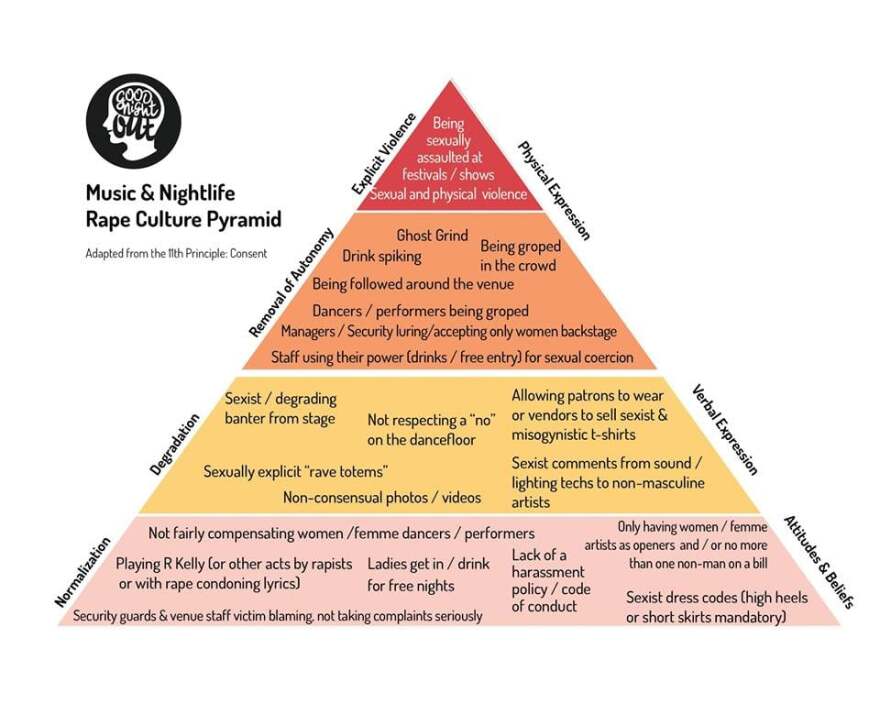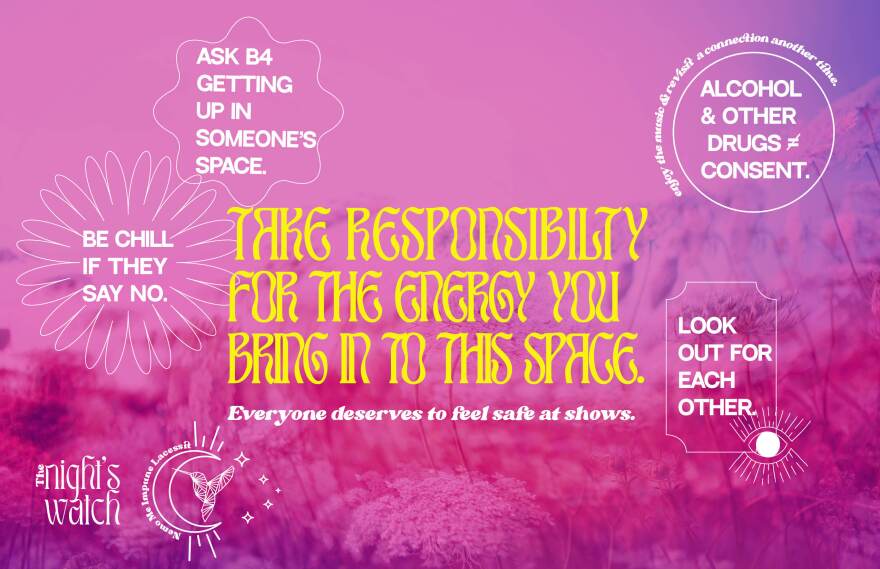Does the following scenario feel familiar? You're at a concert with friends, grabbing a drink at the bar when all of a sudden, a stranger puts their hands on your hips to get your attention. It’s unwanted. As the bartender hands you your drink, you lean in and say, “The guy behind me is getting a little handsy. Can you help me get someone to keep an eye on him?”
Your heart drops as the bartender replies, “That’s not my problem. Go get a security guard.” But security is nowhere to be found. Startled, your thoughts start looping: Am I safe here? Is it safe to go to the bathroom by myself? Would security take me seriously? We better keep an eye on our drinks.
This is a scenario that is unsettlingly familiar to many: this collection of Reddit posts from the Bay Area recounts stories of unwanted touching, sexual assault, and unhelpful staff. Several posts reference drink spiking, which is when “alcohol or other drugs are used to intentionally sedate or incapacitate a person and perpetuate sexual assault” (Good Night Out Vancouver). While posting on Reddit may create space for solidarity and spread awareness, it also suggests a lack of confidence in how staff will respond to reporting incidents of sexual violence.
Four groundbreaking bills have recently been signed into law that take various measures to address drink spiking, drug-facilitated sexual assault (DFSA) and gender-based violence in California bars and nightclubs, creating an opportunity for a larger conversation about sexual violence in nightlife.
The laws require California bars and nightclubs that don’t serve food to post signage that says, “Don’t get roofied! Drink spiking drug test kits available here. Ask a staff member for details.” The author of these laws, Long Beach Assemblymember Josh Lowenthal, said that cutting down on sexual assault is “the only metric we’re looking for,” and that he understands that “no single bill will end drink spiking, sexual assault or rape. But it’s important that we keep adding to the comprehensive approach in addressing this epidemic.”

That’s a great goal, and mandatory test kits at bars and lids to cover your drink (the latter will be required as of July 1, 2025) are tools that can act as a deterrent. But these efforts also reinforce a culture of stigmatization, where the onus is on individuals to stay safe, rather than spurring venue operators to take action to support victims and address a nightlife culture that enables and normalizes this behavior.
In order to take a more comprehensive approach to preventing DFSA, we’ve launched The Night’s Watch—a nightlife advocacy organization that is developing additional infrastructure to address behavior that might make someone feel targeted, uncomfortable, or violated on a night out, inclusive of and beyond drink spiking. Made up of longtime nightlife advocates with backgrounds in event-based harm reduction, venue operation, and city planning and management in the nightlife sector, The Night’s Watch is uniquely positioned to offer the support that establishments need to mitigate the risk factors present in nightlife. The organization was started in response to the founders consistently experiencing sexual harassment on nights out, and the organization envisions nights out free from creepers at bars and on the dance floor.
Understanding the realities of drink spiking and the inherent limitations of the available tools are foundational to Lowenthal’s vision of a “comprehensive approach.” The most commonly available test kits that bars are required to carry in order to be compliant with the law are coasters that test for GHB and ketamine. They do not test for “roofies” – the street name for Rohypnol – making the signage “Don’t get roofied” misleading at best. Plus, a study found that the accuracy of the results is akin to flipping a coin.
While it is valuable to have tools that test for the use of controlled substances in DFSA, alcohol is actually the most commonly used drug in DFSA, making it impossible to test for in an environment where it is legally served. Statistics on and accounts of DFSA are limited and anecdotal at best, but it is estimated that 50-70% of sexual assaults involve alcohol. There are 463,634 sexual assaults reported annually in the United States, but only 1 in 10 are reported in the first place, making it one of the most underreported crimes.

With the new laws applying exclusively to bars and nightclubs, venues are in a unique position to proactively challenge this culture, and they have a responsibility to mitigate the risks that come with serving alcohol. Staff members are on the front lines; it’s important that they have a baseline set of skills around awareness and intervention so they can navigate disclosures with compassion, discretion, and effective assistance.
Innovative messaging around DFSA can help challenge stigmas that might prevent victims and survivors from reporting behavior that makes them feel uncomfortable. Cohesive messaging across a venue’s communication channels— on the website homepage, on social media, and within the venue—can reinforce how operators want patrons to feel and act in their space and deter behavior that does not align with these values. Discreet tools such as SOS cards or code words such as “Ask for Angela” can also help patrons communicate sensitive information in a chaotic environment.
So, what might that same night out referenced at the beginning look like with some of these strategies in place? Maybe you notice a poster about consent in the bathroom that encourages you to report creepy behavior to staff. Maybe the bartender discreetly takes the perpetrator aside, telling them that their behavior is not in line with the venue’s code of conduct posted on their website and that they will be asked to leave if they don’t change their behavior. Venue operators and staff can gain these skills through an organization like The Night’s Watch that provides industry-tailored tools, resources, and policy for the nighttime economy to address and help prevent sexual and gender-based violence.

We also need the government of San Francisco to work with us to connect effectively with local bars and clubs. With its mission to promote a healthy and vibrant nightlife in harmony with community, the SF Entertainment Commission’s recent overdose awareness and prevention campaign has set a strong precedent for employing harm reduction strategies in response to how an epidemic can manifest in the nightlife space.
San Francisco has both an opportunity and a responsibility to continue its legacy as a leader in entertainment by modeling a comprehensive approach for safer and inclusive nightlife, one which shifts the culture that necessitates these laws in the first place.
Elizabeth (she/her) is the Program Director of The Night’s Watch, a nightlife advocacy organization in San Francisco that focuses on addressing and preventing sexual violence at bars, nightclubs, and music festivals. Elizabeth has provided and supported event-based consent programs (outreach services and education) at nightlife events and festivals around the world, including Good Night Out Vancouver programs, and resides in the occupied and unceded ancestral territories of the Raymutush, Ohlone, and Muwekma people.

